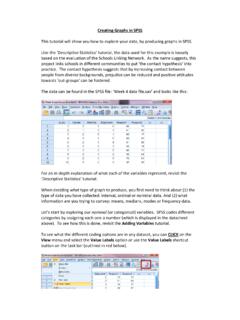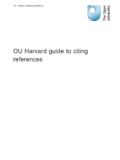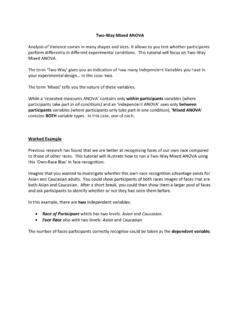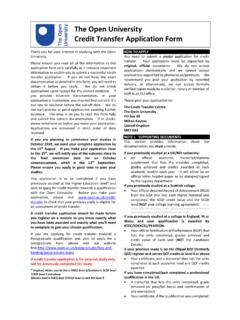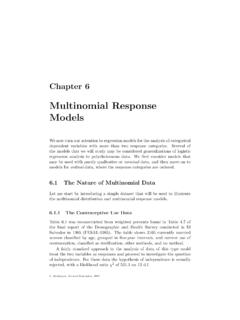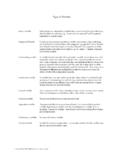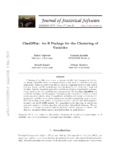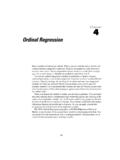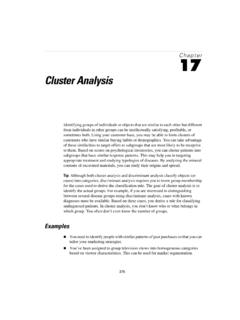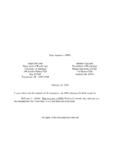Transcription of Adding Variables into SPSS - Open University
1 Adding Variables into spss This tutorial will show you how to create Variables and add data into spss . Using a simple example, let s imagine that we want to investigate the phenomenon of social facilitation . Our simple hypothesis might be that participants perform better on a simple task when in the presence of others. Before we can test our hypotheses, we need to enter this information into spss . See Tutorial 1: Getting Started for how to open a blank data file. To test this hypothesis we could create two experimental groups: one where participants perform a task while being watched by an audience and another where participants perform the same task alone.
2 We could call this variable 'audience presence'. We would then need to measure their performance in some way. For this example, let s consider a really simple task that involves participants being asked to write down as many words as possible that begin with the letter 'f' in 60 seconds. The number of words generated would therefore be the dependent variable . The two groups performance could then be directly compared. Before we add our data, we need to tell spss exactly what information we collected. That is, we need to define our Variables .
3 To do this, you need to CLICK on the variable View tab at the bottom of the screen. We use the variable View in spss to add and define the Variables used in our research. Each row represents one of our Variables . Here, we can give them suitable names and specify the type of data we are entering for each one. We start by typing in the variable names in the Name column. You are only able to use certain characters in this column ( letters and numbers). Spaces and most symbols (such as +, -, &, $) cannot be included in the variable name.
4 This name will appear at the top of the corresponding data columns in the Data View sheet. As such, you don t want to give your Variables long names, as this makes them difficult to read. By clicking on the cells in the Type column, you can change the type of data that is associated with the variable . For most simple data sets in psychology you will be using numeric data. This just means the information associated with your variable contains numbers. It is the option you would use when directly entering participants scores (like exam or questionnaire results, psychometric measurements, reaction times etc).
5 You would also use this option when entering categorical data, for Variables such as gender or group membership. You may also occasionally wish to use string Variables , which consist of strings of letters. For example, if you wanted to type in answers to open ended questions or participants names, you would choose this option. It s unlikely that you would use the other types of Variables here. Clicking on OK will accept any changes that you make here, while Cancel will go back to the variable view window.
6 The Width option allows you to change the number of characters that spss will let you enter for that variable . You can change the width by clicking the arrows that appear at the edge of the cell or by typing in a new number. For this example (and in most cases) a width of 8 characters is fine. The Decimals option allows you to change the number of decimal places spss will display. The default is two, however you may wish to change this to make your data more transparent and meaningful. For example, you may want more information when dealing with reaction times; or less when you are dealing with integers or category groupings.
7 You can change the decimal places by clicking the arrows that appear at the edge of the cell or by typing in a new number. As you saw earlier, the characters spss allows you to enter into the Name column is restricted. This is where the Label column comes in handy. You can label your Variables whatever you want here, allowing you to identify your Variables in more detail. This label is also displayed in your analysis output. While this may not seem particularly useful for a variable such as Audience Presence, it is actually a very good habit to get into - especially when you have large complicated datasets (.)
8 It s surprisingly easy to forget what all of your Variables represent)! For nominal Variables (also called categorical or grouping Variables ) where participants fall into different groups or conditions (in this, audience presence groups), you need to tell spss what these groups are. To do this, you need to assign each group a name and number. The numerical code gets entered into the Data View sheet for each participant. We use the Values column here to indicate what these codes actually mean by telling spss how to map these numbers to the category names (such as 1 to Audience Present and 2 to Audience Absent).
9 To tell spss which category or group participants belong to we enter the code into the Value box and the condition name into the Label box. Use the Add button to add the labels. In this case we are using the following codes: 1 = Present 2= Absent You only need to use the Value Labels box when you are assigning numbers to different groupings or answer categories. While you will never need to do this for interval data; you will for ordinal data. We can use the missing option to tell spss when we have missing data.
10 As spss copes well with empty cells, don t worry about this too much for now. The Columns cell tells spss how wide the column should be for each variable . This is purely aesthetic and different from the Width column, which tells spss how many characters will be displayed. Column size indicates how much space is allocated rather than the degree to which it is filled. The default of 8 is usually fine here. The Align column offers another aesthetic option. In this case you can select whether the data you enter into the cells in the Data View sheet should be left-justified, right-justified, or centred.
